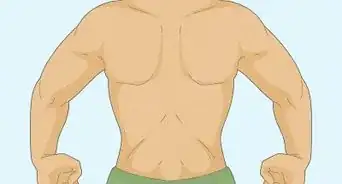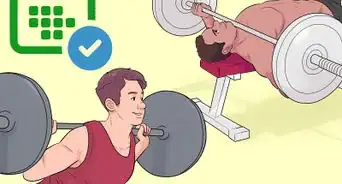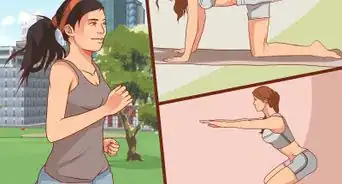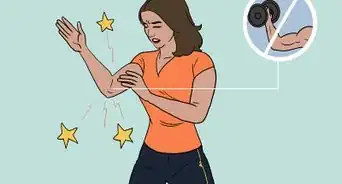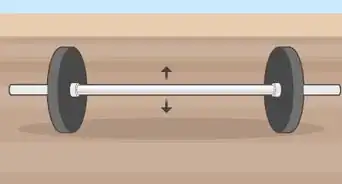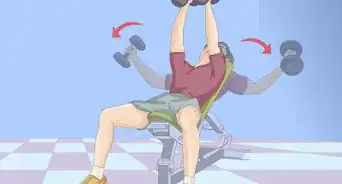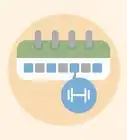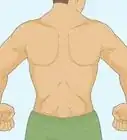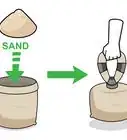This article was co-authored by Laila Ajani. Laila Ajani is a Fitness Trainer and founder of Push Personal Fitness, a personal training organization based in the San Francisco Bay Area. Laila has expertise in competitive athletics (gymnastics, powerlifting, and tennis), personal training, distance running, and Olympic lifting. Laila is certified by the National Strength & Conditioning Association (NSCA), USA Powerlifting (USAPL), and she is a Corrective Exercise Specialist (CES).
wikiHow marks an article as reader-approved once it receives enough positive feedback. In this case, 88% of readers who voted found the article helpful, earning it our reader-approved status.
This article has been viewed 329,137 times.
Lifting straps are useful tools for weight training. If you've gained enough strength to start lifting heavier weights but find that your hand grip isn't strong enough to hold weights for exercises such as dead lifts, weighted pull-ups or shrugs, you can use lifting straps. The straps allow you to lift some of the weight with your wrists so you can hold on long enough to complete your exercise.
Steps
Deciding When to Use Lifting Straps
-
1Use lifting straps for the right exercises. If you are looking to increase muscle size and strength in your upper back, trapezius, and hamstring muscles, lifting straps may be right for you. They allow you to lift more weight to work these muscles than your natural grip might allow.[1] Specifically, they are good for the following exercises:[2]
- Dumbbell or barbell rows
- Shrugs
- Deadlifts
- Romanian deadlifts
- Rack pulls
-
2Avoid using lifting straps for the wrong exercises. First, it is important to note that lifting straps are not allowed in power lifting competitions. If you are training to power lift, don't use straps all the time, because you need a strong natural grip.[3]
- Make sure to do at least some reps with your natural grip, even if it means you can't lift as heavy a weight.
- Additionally, these straps are only helpful for lifts in which gravity is working against your ability to hold on to the weight. Lifting straps do not aid in bench presses or similar exercises. Using them for these lifts may result in ridicule from other weight lifters.[4]
Advertisement -
3Select the right lifting straps. Lifting straps are sewn from heavy-duty cotton, nylon, or leather.The varying materials and styles of these straps provide different advantages to the lifter. Here are some guidelines in choosing straps.
- Make sure they are well stitched and strong.
- Cotton and nylon straps are firmer than leather straps and are less easily bent out of shape. Leather straps have a little more give. This makes them a better choice if you plan to wear them to clean, though many weightlifters don't believe straps should be used for this lift anyway.[5]
- Nylon straps allow you to release the dumbbell the most quickly.
- Olympic/speed straps are shorter. These allow for easier and faster release of the barbell, but a less firm grip, because the strap wraps around the barbell fewer times.
- Although you can buy padded straps, straps with hook-and-loop fasteners, and weightlifting gloves with straps or hooks built in, these don't offer much improvement in function or comfort and are more expensive. Further, hook straps don't fit all barbells and can negatively affect your technique for some lifts.[6]
Putting on Lifting Straps
-
1Thread the ends of the straps through the loops. This will form a circle at 1 end of the strap. If using another type of strap (e.g. hook-and-loop straps or Olympic straps), skip this step.
-
2Put the straps on. Slide your hands through the circles or attach the straps with the hook-and-loop fasteners so the end of the straps hang down along your fingers. Pull on the ends of the straps or adjust the fasteners until the straps fit snugly around your wrists.[7]
-
3Wrap the ends of the strap around the bar (or bars) holding the weight. Start by going under the bar from back to front, and then wrapping the strap over the top and under again. Wrap the strap completely around the bar.[8]
- Some weight trainers prefer to wrap the straps in a figure-8 configuration. This can lead to a better grip on the barbell, but some people complain that after many reps, it can make the bar less comfortable to hold on to or even lead to friction burns.
-
4Place your hands over the straps. Close your palm and fingers over the area where the straps are wrapped around the barbell. This is what holds them in place. When you let go, they should slide off easily.[9] If you're uncomfortable, re-wrap the straps to tighten or loosen as necessary.
Lifting Weight Using Lifting Straps
-
1Roll the bar toward you. Rolling the bar will tighten the strap. Do this until the straps pull on your wrists. Do not start lifting before the straps are tight--you will not get the full benefit of using lifting straps and may increase the risk of injury.[10]
-
2Lift the weight. Take care not to force your wrists to hold the entire weight as you lift. The lifting straps should let your wrists assist you in maintaining your grip on the bar, not do all the work.
- You can injure your wrists by relying too heavily on them to lift the weight, so use your grip as well.
-
3Strengthen your grip. Use hand grips, squeeze the barbell during reps, do fist or fingertip push-ups, climb ropes, or hang from the pull-up bar to strengthen your grip so you don't have to rely too much on your lifting straps.[11]
- Lifting straps often cause weight trainers to ignore the need to strengthen their grips. This can be a real problem, especially if you compete in a sport that doesn't allow you to use straps.
Expert Q&A
-
QuestionHow do you use lifting straps to move furniture?
 Michele DolanMichele Dolan is a BCRPA certified Personal Trainer in British Columbia. She has been a personal trainer and fitness instructor since 2002.
Michele DolanMichele Dolan is a BCRPA certified Personal Trainer in British Columbia. She has been a personal trainer and fitness instructor since 2002.
Certified Fitness Trainer The straps can be looped under the furniture. Holding onto the two ends of the straps is often much easier than getting your arms and hands positioned around large furniture.
The straps can be looped under the furniture. Holding onto the two ends of the straps is often much easier than getting your arms and hands positioned around large furniture. -
QuestionWhat do weight lifting belts do?
 Michele DolanMichele Dolan is a BCRPA certified Personal Trainer in British Columbia. She has been a personal trainer and fitness instructor since 2002.
Michele DolanMichele Dolan is a BCRPA certified Personal Trainer in British Columbia. She has been a personal trainer and fitness instructor since 2002.
Certified Fitness Trainer Weight lifting belts are worn to provide extra support around the abdominal muscles and lower back.
Weight lifting belts are worn to provide extra support around the abdominal muscles and lower back. -
QuestionWhat are bodybuilding straps?
 Michele DolanMichele Dolan is a BCRPA certified Personal Trainer in British Columbia. She has been a personal trainer and fitness instructor since 2002.
Michele DolanMichele Dolan is a BCRPA certified Personal Trainer in British Columbia. She has been a personal trainer and fitness instructor since 2002.
Certified Fitness Trainer Straps are very strong strips of cloth that can be wrapped around wrists or bars to assist with grip and prevent slip.
Straps are very strong strips of cloth that can be wrapped around wrists or bars to assist with grip and prevent slip.
Warnings
- It is common for lifters using straps to become overconfident and make sloppy mistakes. Take the same care when using straps as if you were not using them, and don't lift more than you are comfortable lifting, as this can lead to injury.⧼thumbs_response⧽
References
- ↑ Laila Ajani. Fitness Trainer. Expert Interview. 21 October 2019.
- ↑ http://www.bodybuilding.com/fun/how-why-and-when-to-use-wrist-straps.html
- ↑ http://www.bodybuilding.com/fun/how-why-and-when-to-use-wrist-straps.html
- ↑ http://www.aworkoutroutine.com/weight-lifting-straps/
- ↑ http://breakingmuscle.com/strength-conditioning/weight-lifting-straps-what-they-are-when-and-why-to-use-them
- ↑ http://www.bodybuilding.com/fun/how-why-and-when-to-use-wrist-straps.html
- ↑ http://www.ironmind.com/articles/jim-schmitz-on-the-lifts/Straps-What-How-Why-and-When-to-Use-Them/
- ↑ http://www.ironmind.com/articles/jim-schmitz-on-the-lifts/Straps-What-How-Why-and-When-to-Use-Them/
- ↑ http://www.ironmind.com/articles/jim-schmitz-on-the-lifts/Straps-What-How-Why-and-When-to-Use-Them/
About This Article
To use lifting straps, start by threading the ends of the straps through their loops to make circles. Then, slide your hands through the circles and pull on the ends of the straps so they fit snugly around your wrists. Next, wrap the ends of the straps around the bar holding the weight. Start by going under the bar from back to front, then wrap the straps over the top and under again. When the straps are completely wrapped around the bar, put your hands over the straps. You can then roll the bar toward you, which will tighten the straps, and lift the weight. For tips from our Personal Trainer reviewer on how to pick the right lifting straps and choose which exercises to use them with, read on!





